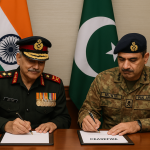The Indian Air Force (IAF) has confirmed the successful execution of key objectives under Operation Sindoor, a military response to the deadly April 22 terrorist attack in Pahalgam, Jammu and Kashmir. In an official statement issued at 07:01 UTC, the IAF announced that the operation remains ongoing and emphasized the importance of public restraint regarding speculation or unverified information.
Operation Sindoor, launched on May 7, 2025, was initiated following the attack that claimed the lives of 26 civilians, primarily Hindu tourists. The incident, which also took the lives of a Christian visitor and a local Muslim resident, has drawn widespread condemnation both nationally and internationally. Security agencies have since identified three individuals allegedly linked to the assault, including Lashkar-e-Taiba leader Hafeez Saeed and his deputy Saifullah Kasuri, both reportedly based in Pakistan. A third suspect, Hashim Moosa, is believed to be hiding in south Kashmir.
According to a report, on May 8 India launched strikes on nine terror sites located within Pakistan and Pakistan-occupied Kashmir (PoK) in a calibrated response. These operations have led to heightened military activity along the Line of Control (LoC), with Pakistan violating the ceasefire agreement by initiating unprovoked shelling. As of May 11, India Today reported at least 12 civilian casualties in Kashmir due to the renewed hostilities.
In its official communication, the IAF described the mission as being executed in a “deliberate and discreet manner,” prioritizing national security while avoiding unnecessary disclosure. The force assured that a comprehensive briefing on the operation will follow in due course and appealed to the public and media to exercise caution in circulating unverified reports.
Amid growing concerns over a potential escalation, civil defense protocols have been activated across India. Reports indicate mock drills, blackout exercises, and air raid sirens have been implemented in 244 districts to prepare for any retaliatory action by Pakistan.
On the diplomatic front, tensions have prompted international engagement. Pakistani Prime Minister Shehbaz Sharif has acknowledged mediation efforts by the United States, Saudi Arabia, the UAE, Turkiye, and Iran. He also called for renewed dialogue over the Indus Waters Treaty. Meanwhile, China’s Foreign Minister Wang Yi expressed support for a ceasefire in a conversation with India’s National Security Advisor Ajit Doval, according to Global Times.
Domestically, the Indian government has come under scrutiny for alleged lapses in security planning. Critics, citing information from Wikipedia, argue that the early reopening of Baisaran Valley to tourists without adequate coordination with security forces may have contributed to the attack’s success. In response, an all-party meeting was convened in Delhi on May 8 to update political leaders on Operation Sindoor and the broader security situation.
With a strength of 135,000 personnel as of January 2025, the Indian Air Force remains a cornerstone of the country’s defense apparatus. The force has a history of decisive engagement, including the 1999 downing of a Pakistan Navy aircraft over Sir Creek, underscoring its operational legacy.
As developments along the India-Pakistan border continue to unfold, the IAF’s measured communication strategy reflects the complex balance between operational secrecy and public transparency. The nation remains on high alert as diplomatic and military efforts aim to contain further escalation.













